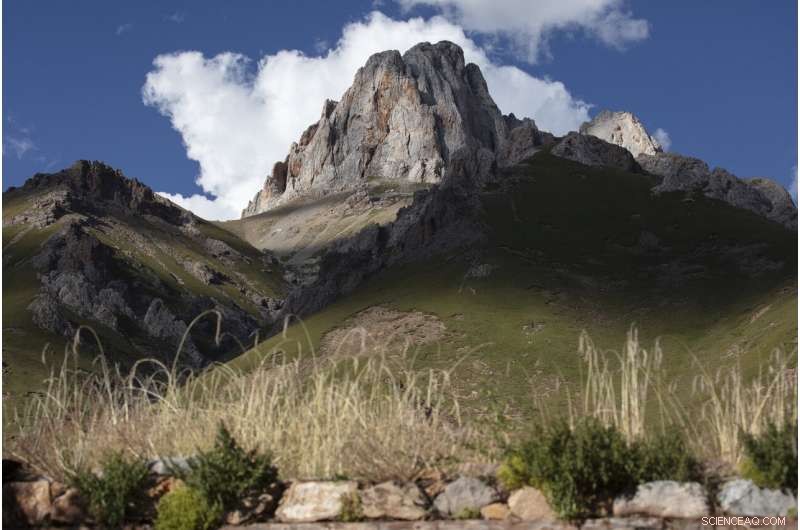
Picos alcançam o céu em Angsai, uma área dentro da região de Sanjiangyuan, na província de Qinghai, oeste da China, no domingo, 25 de agosto, 2019. Rodeado pelas cadeias de montanhas mais altas do mundo, a região há muito conhecida como "o telhado do mundo" está agora na mira do último esforço de modernização da China. Mas desta vez, o governo chinês quer estabelecer limites para o crescimento da região a fim de implementar sua própria versão de um dos mais orgulhosos legados dos EUA - um sistema de parques nacionais. (AP Photo / Ng Han Guan)
Há um boom de construção no planalto tibetano, um dos últimos lugares remotos do mundo. Montanhas há muito coroadas por guirlandas de bandeiras de oração esvoaçantes - uma bênção tradicional da paisagem - foram recentemente cobertas por extensas linhas de energia de aço. À noite, as placas iluminadas dos postos de gasolina Sinopec lançavam um brilho vermelho sobre as rodovias recém-construídas.
Rodeado pelas cadeias de montanhas mais altas do mundo, a região há muito conhecida como "o telhado do mundo" está agora na mira do último esforço de modernização da China, marcado pela multiplicação de arranha-céus e expansão de linhas ferroviárias de alta velocidade.
Mas desta vez, há uma diferença:o governo chinês também quer estabelecer limites para o crescimento da região a fim de projetar sua própria versão de um dos mais orgulhosos legados dos EUA - um sistema de parques nacionais.
Em agosto, legisladores e cientistas da China, os Estados Unidos e outros países reunidos em Xining, capital da província de Qinghai no país, para discutir os planos da China de criar um sistema de parque unificado com padrões claros para limitar o desenvolvimento e proteger os ecossistemas.
A economia do país cresceu nos últimos 40 anos, mas as prioridades agora estão se expandindo para incluir a conservação dos principais recursos naturais, diz Zhu Chunquan, o representante da China da União Internacional para a Conservação da Natureza, um grupo científico com sede na Suíça.
“É muito urgente identificar os locais o mais rápido possível, os ecossistemas e outras características naturais "para proteger, Zhu diz.

Uma mulher tibetana cuida de uma criança em Angsai, uma área dentro da região de Sanjiangyuan, na província de Qinghai, oeste da China, no domingo, 25 de agosto, 2019. Uma questão-chave paira sobre o projeto de parques nacionais do país:Será que a China pode casar os objetivos de conservação e turismo, ao mesmo tempo que salvaguarda os meios de subsistência e a cultura de aproximadamente 128, 000 pessoas que vivem dentro ou perto dos limites do parque, muitos deles tibetanos? (AP Photo / Ng Han Guan)
Entre outros objetivos, A China pretende construir seu próprio Yellowstone no planalto tibetano.
Zhu atua em um comitê consultivo que fornece informações sobre o desenvolvimento do nascente sistema de parques nacionais da China, deverá ser revelado oficialmente em 2020. As autoridades chinesas também visitaram os parques nacionais dos EUA, incluindo Yellowstone e Yosemite, e buscou contribuições de várias organizações, incluindo o Paulson Institute e a Nature Conservancy, com sede em Chicago.
A ambição de criar um sistema de parque unificado representa "um novo e sério esforço para salvaguardar a biodiversidade e o patrimônio natural da China, "Stuart Pimm, ecologista da Duke University, diz.
Um dos primeiros parques piloto será em Qinghai, uma vasta região no oeste da China confinando com o Tibete e compartilhando muito de seu legado cultural. A área também é o lar de espécies icônicas e ameaçadas como o leopardo da neve e o gato da montanha chinês, e abrange as cabeceiras de três grandes canais da Ásia:o Yangtze, Rios Yellow e Mekong.
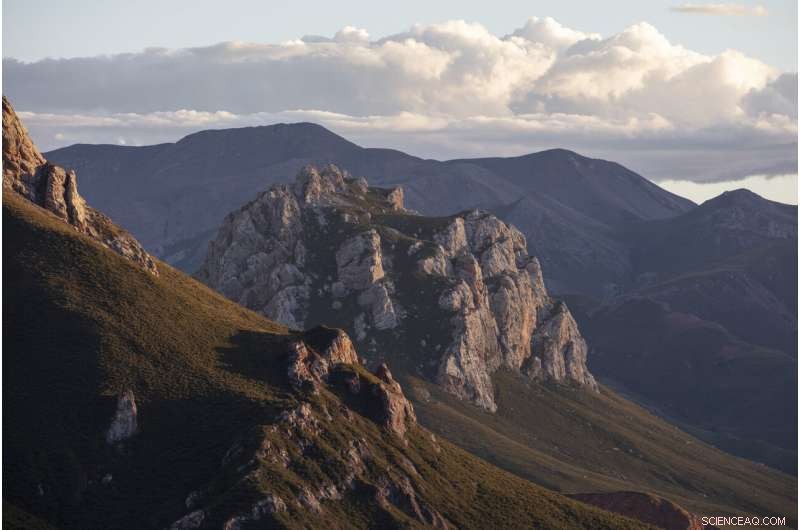
Nuvens pairam sobre a paisagem montanhosa de Angsai, uma área dentro da região de Sanjiangyuan, na província de Qinghai, oeste da China, no domingo, 25 de agosto, 2019. A China pretende construir seu próprio Yellowstone no planalto tibetano. (AP Photo / Ng Han Guan)
"Esta é uma das regiões mais especiais da China, no mundo, "diz Lu Zhi, um biólogo conservacionista da Universidade de Pequim que trabalhou em Qinghai por duas décadas.
Enquanto a construção continua em um ritmo frenético em outras partes do planalto tibetano, o governo já parou de emitir licenças de mineração e hidrelétricas nesta região.
Mas uma questão chave paira sobre o projeto:a China pode casar os objetivos de conservação e turismo, ao mesmo tempo que salvaguarda os meios de subsistência e a cultura de aproximadamente 128, 000 pessoas que vivem dentro ou perto dos limites do parque, muitos deles tibetanos?
"A China tem uma população densa e uma longa história, "Zhu diz." Uma das características únicas dos parques nacionais da China é que eles têm moradores locais morando dentro ou nas proximidades. "
Yellowstone é amplamente considerado o primeiro parque nacional do mundo. Depois que foi criado em 1872, o governo dos EUA forçou os nativos americanos que viviam na área a se reinstalarem fora dos limites do parque, de acordo com a noção do século 19 de que a proteção da selva significava natureza separada das pessoas. Mas os países que tentam estabelecer sistemas de parques no século 21 agora devem considerar a melhor forma de incluir as populações locais em seu planejamento.
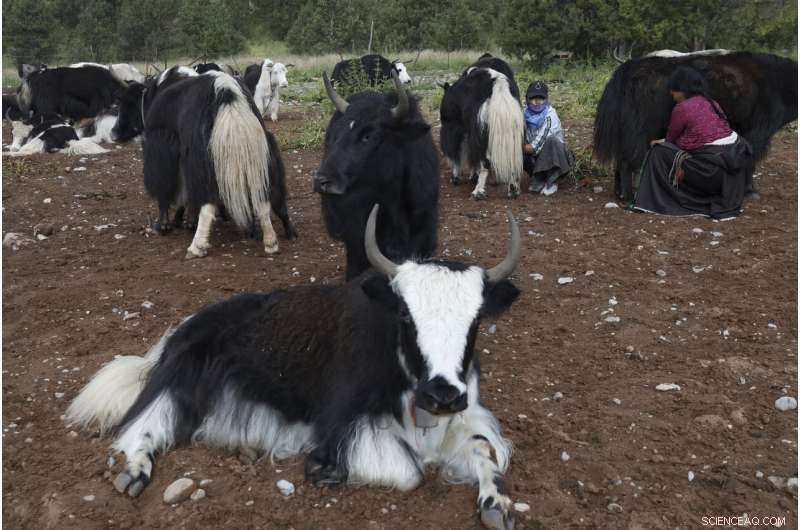
Mulheres tibetanas ordenham seus iaques em Angsai, uma área dentro da região de Sanjiangyuan, na província de Qinghai, oeste da China, no domingo, 25 de agosto, 2019. Qinghai é uma vasta região no oeste da China que faz fronteira com o Tibete e compartilha muito de seu legado cultural. (AP Photo / Ng Han Guan)
"Descobrir como alcançar a conservação ecológica e o apoio às comunidades ao mesmo tempo - essa é a dificuldade mais complicada que você tem, "diz Jonathan Jarvis, ex-diretor do Serviço Nacional de Parques dos EUA e agora professor da Universidade da Califórnia, Berkeley, que visitou o parque piloto Qinghai, chamado Sanjiangyuan.
A China já empreendeu vastos programas de reassentamento para limpar terras para grandes projetos de infraestrutura, como a Barragem das Três Gargantas e o Projeto de Transferência de Água Sul-Norte. Esses reassentamentos deixaram muitos agricultores em novas casas, sem campos agrícolas adequados ou acesso a outros meios de subsistência.
Mas no desenvolvimento dos parques nacionais, o governo está dando empregos relacionados à conservação para pelo menos uma porção de pessoas que vivem em Sanjiangyuan para que permaneçam e trabalhem em suas terras. A "Uma Família, O programa One Ranger "contrata uma pessoa por família por 1.800 yuans por mês (US $ 255) para realizar tarefas como coleta de lixo e monitoramento de caça ilegal ou atividade ilegal de pastagem.
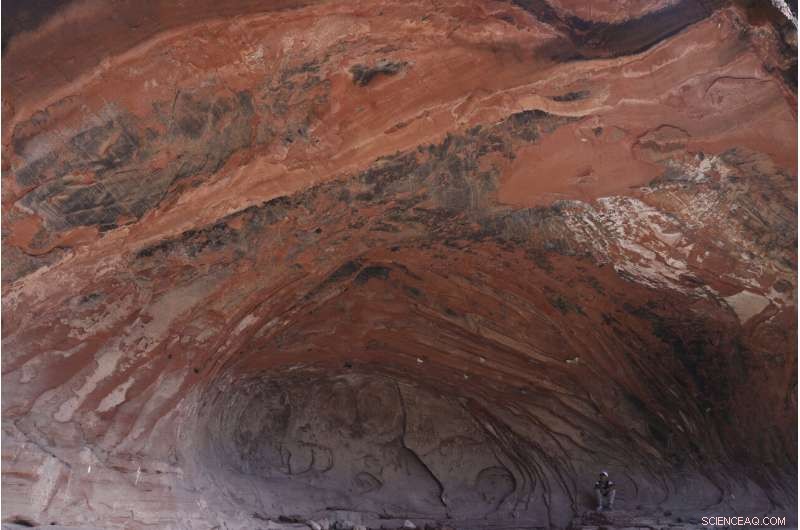
Um jovem tibetano senta-se na base de uma formação natural de caverna em Angsai, uma área dentro da região de Sanjiangyuan, na província de Qinghai, oeste da China, no domingo, 25 de agosto, 2019. China has previously undertaken vast resettlement programs to clear land for large infrastructure projects, but in developing the national parks, the government is giving conservation-related jobs to at least a swath of people living in Sanjiangyuan to stay and work on their land. (AP Photo / Ng Han Guan)
It's difficult to interview residents in China's ethnic borderlands like Qinghai, due to restrictions on journalists that make it hard to travel widely or freely in those areas. Regions with large ethnic and religious minorities, including all Tibetan areas, are subject to heightened political and religious controls.
But a few people living in Angsai, a Tibetan village located within the new Qinghai park, were willing to speak, although it's not possible to determine if their experiences are typical.
A-Ta is a Tibetan herder whose income largely comes from raising yaks and collecting caterpillar fungus, a folk medicine taken as a purported aphrodisiac or for respiratory problems. He also leads a team of trash collectors, traveling as much as 34 kilometers (21 miles) a day to comb the hillsides for plastic bottles and other waste as part of the "One Family, One Ranger" program.

A-Ta, at right stands near his father in their home in Angsai, an area inside the Sanjiangyuan region in western China's Qinghai province on Monday, 26 de agosto 2019. A-Ta, a Tibetan herder whose income largely comes from raising yaks and collecting caterpillar fungus, also leads a team of trash collectors traveling as much as 34 kilometers (21 miles) a day to comb the hillsides for plastic bottles and other waste, as part of the "One Family, One Ranger" program. (AP Photo/Ng Han Guan)
"I am living in this land, my living is relying on this land, " ele diz, as his sister heats a kettle in their modest home. A poster showing the faces of China's past leaders and current Communist Party general secretary, Xi Jinping, hangs on the wall.
A-Ta says he is grateful for work that allows his family to stay on their land, even as people in other parts of Qinghai have had to leave. His own son is employed leading a relocation program for "a huge population of nomads" in Dzarto, a county in southern Qinghai.
"I love this land very much, " he says. "I always motivate and encourage people to protect the environment and contribute to the conservation work."
Kunchok Jangtse is a Tibetan herder who also earns money cleaning up rubbish through the "One Family, One Ranger" program.
He has an additional volunteer position through the Chinese nonprofit Shanshui—the name means "mountain, water"—installing and maintaining motion-activated camera traps, which help scientists monitor endangered species in Qinghai.
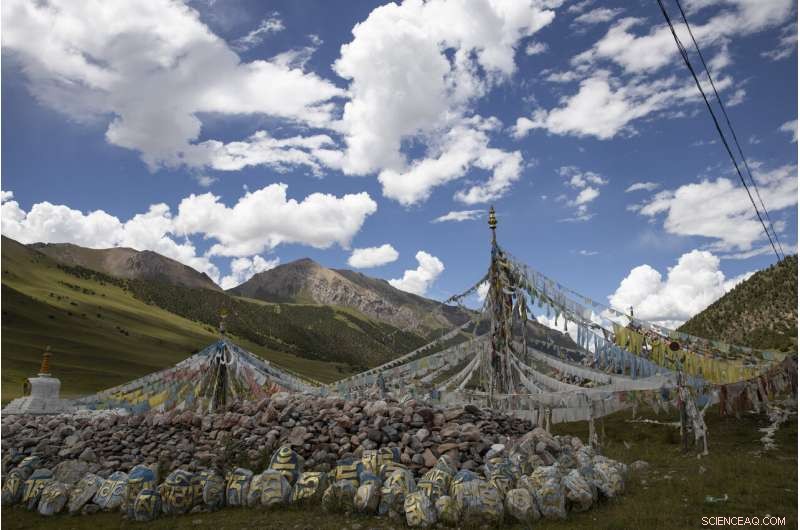
Tibetan prayer flags are seen during a clear day in Angsai, an area inside the Sanjiangyuan region in western China's Qinghai province on Monday, 26 de agosto 2019. Qinghai is a vast region in western China abutting Tibet and shares much of its cultural legacy. (AP Photo / Ng Han Guan)
As he affixes a camera trap to a thin tree trunk, ele explica, "The reason why it has to be installed in this location is because this is the main migration route of the majority of wild animals."
Such camera traps have captured rare footage of snow leopards and Chinese mountain cats, including mothers and their cubs playing near a temporary den.
Kunchok Jangtse says the work of protecting the environment, including reporting illegal poaching activity, é importante.
"Our religion is connected with wild animals, because wild animals have a consciousness and can feel love and compassion—therefore, we protect wild-animals, " ele diz.
From his main work raising livestock and collecting caterpillar fungus, Kunchok Jangtse says he can make about 20, 000 yuan ($2, 830) a year. He is grateful for the additional income from the ranger program, but mainly hopes his other livelihood won't be impeded—and that he won't eventually be forced to leave.
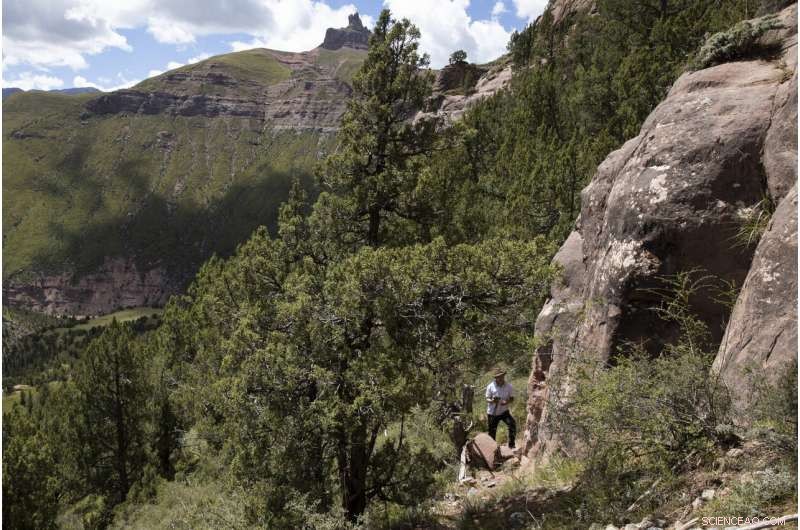
Kunchok Jangtse, a Tibetan herder who also instals and maintains motion-activated cameras, works on a camera in Angsai, an area inside the Sanjiangyuan region in western China's Qinghai province on Tuesday, 27 de agosto, 2019. His work helps scientists monitor endangered species. "I'm not a highly educated person, and I am very concerned it may bring many difficulties in my life if I would switch my job and move to another place, " he says. (AP Photo/Ng Han Guan)
"I'm not a highly educated person, and I am very concerned it may bring many difficulties in my life if I would switch my job and move to another place, " ele diz.
The question of local people's culture and livelihoods is one of the top concerns that former U.S. National Park Service director Jarvis says China has to wrestle with, along with establishing laws and funding.
"They need a legal framework that defines what a park is, " Jarvis says. "And they need sustainable funding."
The creation of protected areas is not a new idea in China. Na verdade, roughly 15% of the country's land already is assigned to a bewildering patchwork of local and regional parks. But many existing reserves are simply parks on paper, run by various agencies without enforceable guidelines.
Em contraste, the national parks system is being designed from the ground-up to incorporate global best practices and new science.
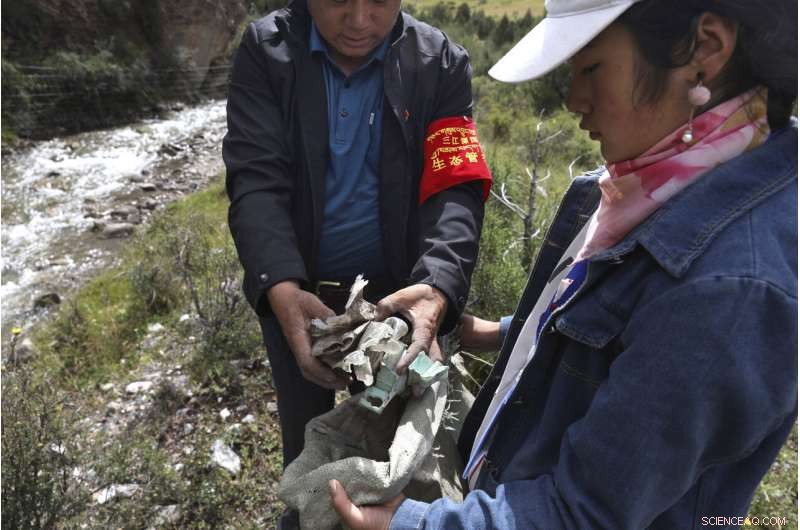
A-Ta, a Tibetan herder whose income largely comes from raising yaks and collecting caterpillar fungus, places refuse in a bag as he leads his team of trash collectors in Angsai, an area inside the Sanjiangyuan region in western China's Qinghai province on Monday, 26 de agosto 2019. His team travels as much as 34 kilometers (21 miles) a day to comb the hillsides for plastic bottles and other waste, as part of the "One Family, One Ranger" program. "I am living in this land, my living is relying on this land, " he says. (AP Photo/Ng Han Guan)
In his office in Beijing, Ouyang Zhiyun, deputy director at the Chinese Academy of Sciences' Research Center for Eco-Environmental Sciences, pores over hundreds of carefully shaded maps of mainland China that denote priority areas for protecting threatened and endangered species, as well as "eco-system services, " like safeguarding water supplies and limiting soil erosion.
The question isn't just how much total land you're protecting, but which lands you're protecting, ele observa.
Recentemente, Ouyang was the lead scientist for China's sweeping "national ecosystems assessment, " which used 20, 000 satellite images and 100, 000 field surveys to examine how China's land changed between 2000 and 2010, with some of the findings published in the journal Science in 2016. One resulting statistic:China's urban area increased 28% during that period.
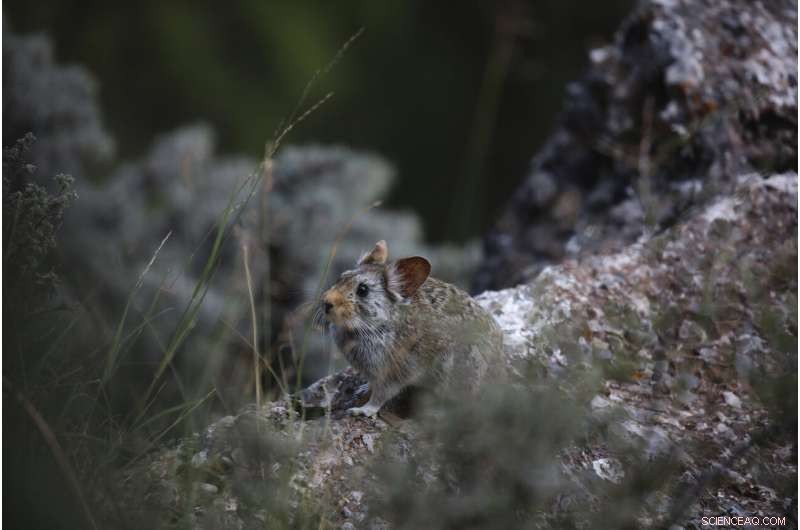
A Glover's Pika surveys its surrounding in Angsai, an area inside the Sanjiangyuan region in western China's Qinghai province on Tuesday, 27 de agosto, 2019. (AP Photo/Ng Han Guan)
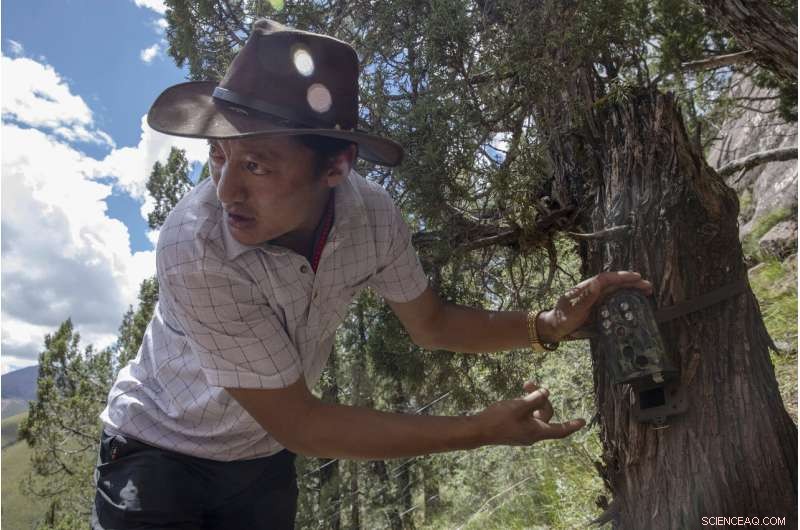
Kunchok Jangtse positions a camera trap in Angsai, an area inside the Sanjiangyuan region in western China's Qinghai province on Tuesday, 27 de agosto, 2019. The Tibetan herder also has a job installing and maintaining the motion-activated cameras, which help scientists monitor endangered species in the area. "Our religion is connected with wild animals, because wild animals have a consciousness and can feel love and compassion—therefore, we protect wild-animals, " he says. (AP Photo/Ng Han Guan)
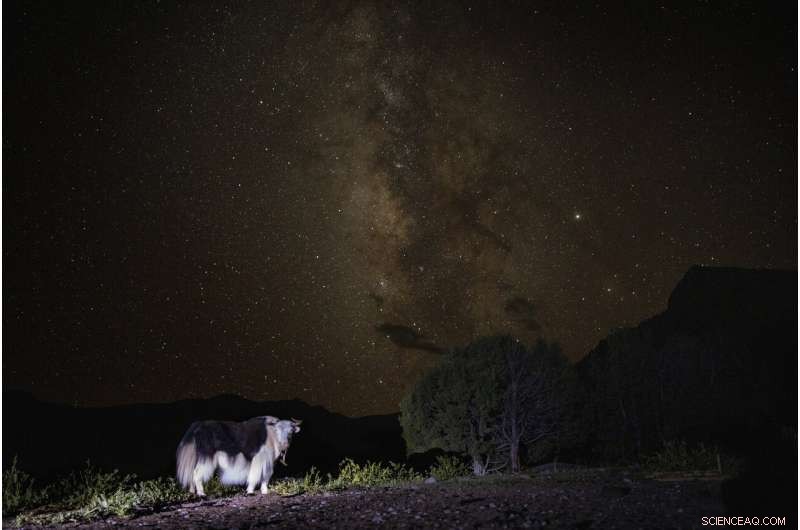
The Milky Way glows behind a yak in Angsai, an area inside the Sanjiangyuan region in western China's Qinghai province on Monday, 26 de agosto 2019. "This is one of the most special regions in China, no mundo, " says Lu Zhi, a Peking University conservation biologist who has worked in Qinghai for two decades. (AP Photo / Ng Han Guan)
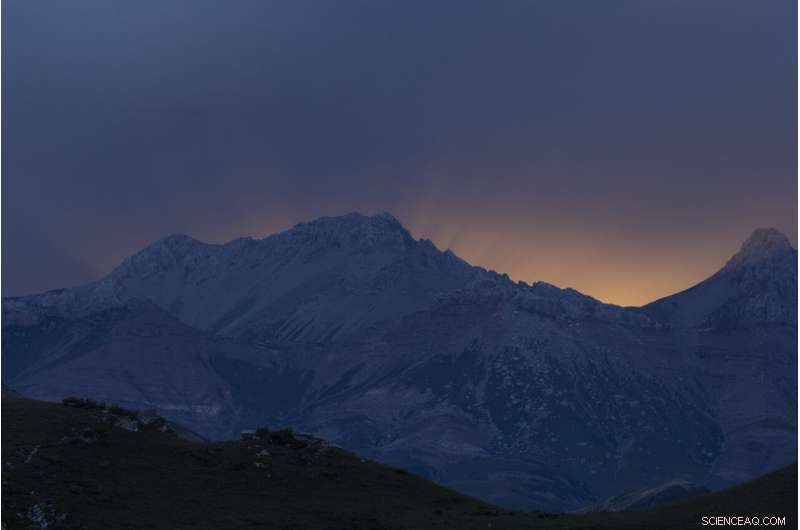
A sunset casts rays of light over the top of a mountain range in Angsai, an area inside the Sanjiangyuan region in western China's Qinghai province on Monday, 26 de agosto 2019. "This is one of the most special regions in China, no mundo, " says Lu Zhi, a Peking University conservation biologist who has worked in Qinghai for two decades. (AP Photo / Ng Han Guan)

A bat flies through a narrow crevice in Wuyishan in eastern China's Fujian province on Tuesday, 13 de agosto, 2019. (AP Photo/Ng Han Guan)

A monkey bares its teeth at visitors in an animal shelter that is part of tourist site in Wuyishan in eastern China's Fujian province on Friday, 16 de agosto, 2019. (AP Photo/Ng Han Guan)
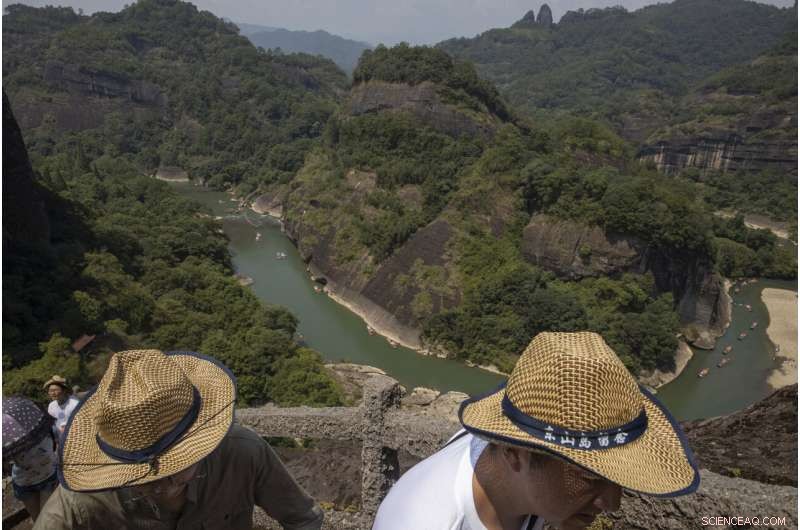
Visitors climb Tianyou peak in Wuyishan in eastern China's Fujian province on Wednesday, Aug. 14, 2019. The ambition to create a unified park system represents "a new and serious effort to safeguard China's biodiversity and natural heritage, " says Duke University ecologist Stuart Pimm. (AP Photo/Ng Han Guan)

Women work on a photo for their tea products on a mountain top in Wuyishan in eastern China's Fujian province on Wednesday, Aug. 14, 2019. Zhu Chunquan, the China representative of the International Union for the Conservation of Nature, a Switzerland-based scientific group, notes that the country's economy has boomed over the past 40 years. But priorities are now expanding to include conserving the country's key natural resources. "It's quite urgent, as soon as possible to identify the places, the ecosystems and other natural features" to protect, Zhu says. (AP Photo / Ng Han Guan)
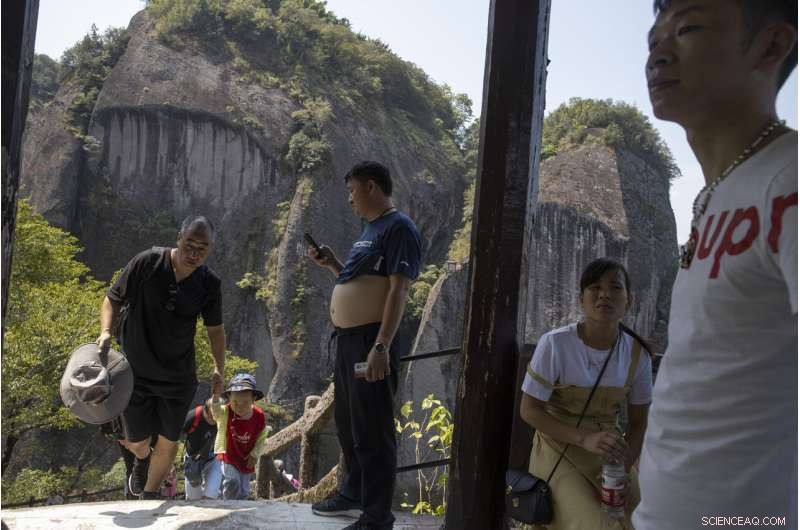
Visitors rest in a pavilion during a climb up Tianyou peak in Wuyishan in eastern China's Fujian province on Wednesday, Aug. 14, 2019. (AP Photo/Ng Han Guan)
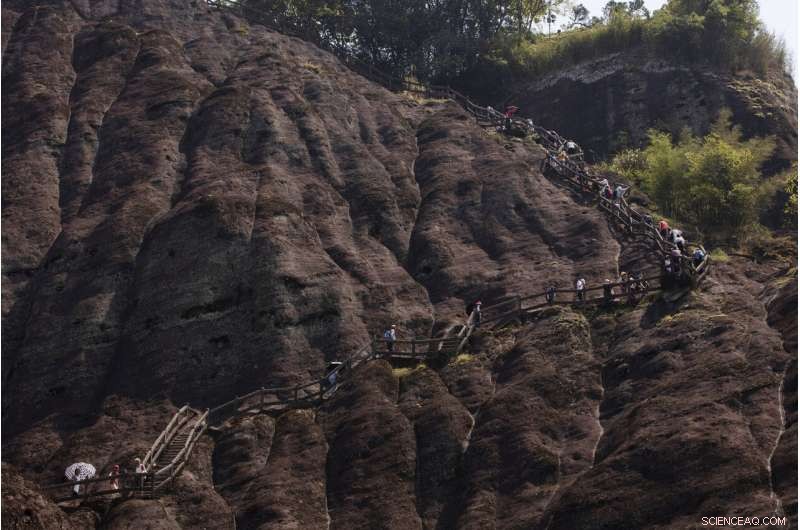
Visitors climb Tianyou peak in Wuyishan in eastern China's Fujian province on Wednesday, Aug. 14, 2019. (AP Photo/Ng Han Guan)
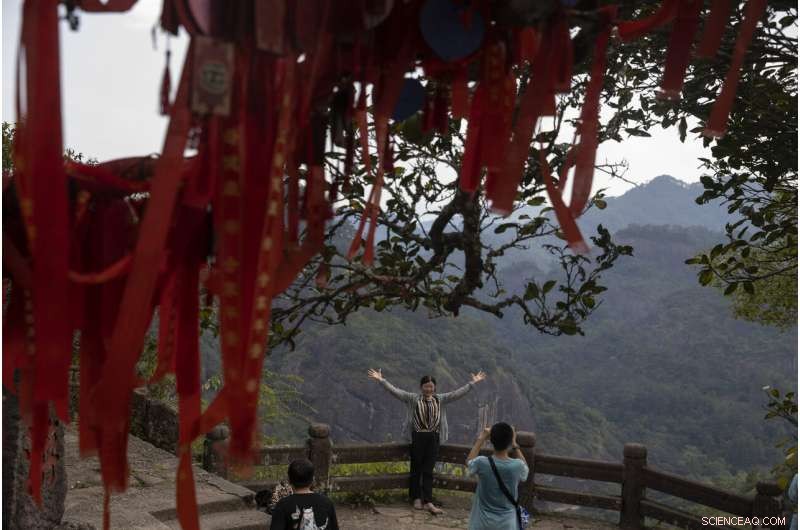
A visitor poses for a photo on Tianyou peak in Wuyishan in eastern China's Fujian province on Wednesday, Aug. 14, 2019. (AP Photo/Ng Han Guan)
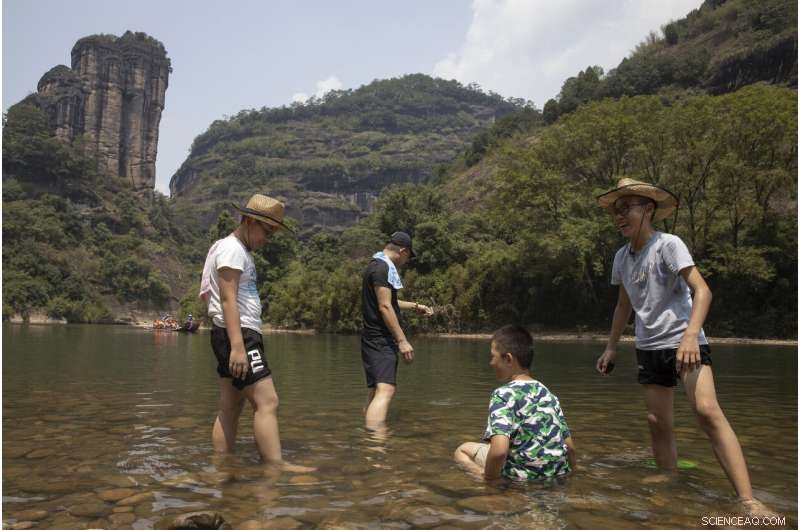
A woman poses for photos near a waterfall in Wuyishan in eastern China's Fujian province on Thursday, 15 de agosto, 2019. (AP Photo/Ng Han Guan)

Tourists stand in shallow water along the Nine Bends River in Wuyishan in eastern China's Fujian province on Thursday, 15 de agosto, 2019. (AP Photo/Ng Han Guan)
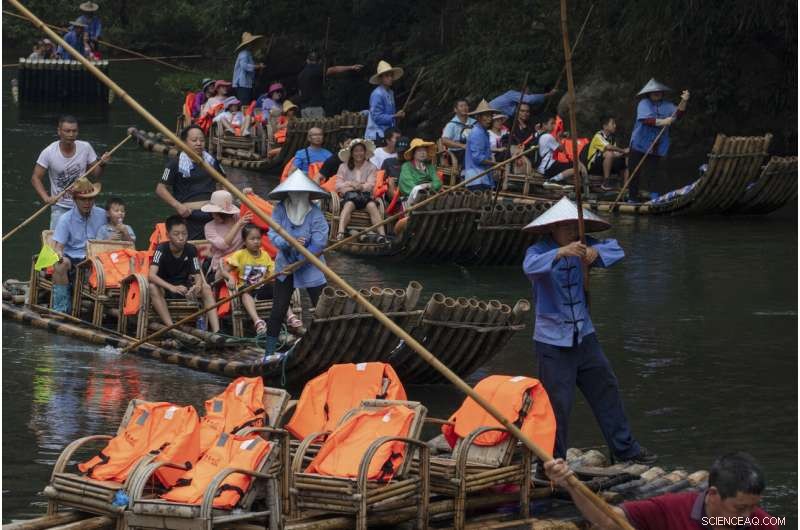
Tourists ride in bamboo rafts during a tour of the Nine Bends River in Wuyishan in eastern China's Fujian province on Thursday, 15 de agosto, 2019. In August 2019, policymakers and scientists from China, the United States and other countries met in China to discuss the country's plans to create a unified park system with clear standards for limiting development and protecting ecosystems. (AP Photo / Ng Han Guan)
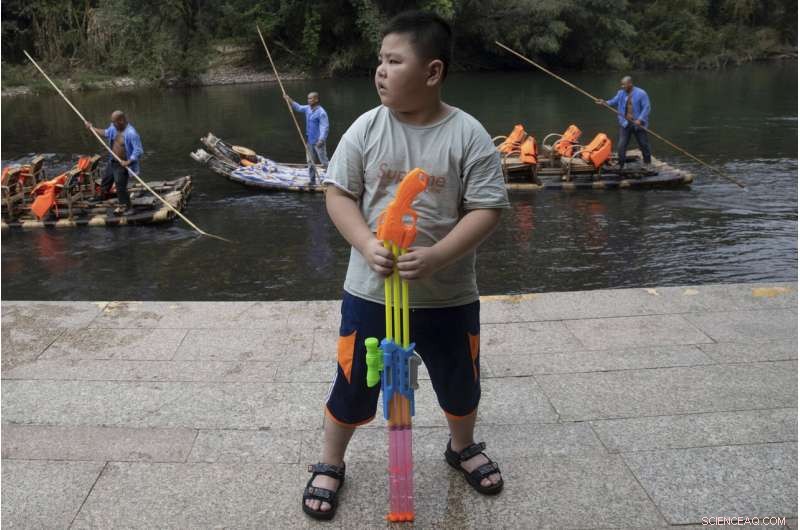
A boy holds a water rifle on the banks of the Nine Bends River as bamboo raft operators wait for tourists in Wuyishan in eastern China's Fujian province on Thursday, 15 de agosto, 2019. Zhu Chunquan, the China representative of the International Union for the Conservation of Nature, a Switzerland-based scientific group, notes that the country's economy has boomed over the past 40 years. But priorities are now expanding to include conserving the country's key natural resources. "It's quite urgent, as soon as possible to identify the places, the ecosystems and other natural features" to protect, Zhu says. (AP Photo / Ng Han Guan)
Now Ouyang is drawing upon that work, combined with surveys of more than 1, 500 species of endangered and threatened plants and animals, to map priority areas for conservation and advise park planners. He is focusing on habitats of endangered species that live only in China.
"If we lose it here, foi-se, " ele diz.
The first parks to be formally incorporated into China's national park system will showcase the country's vast and varied landscapes and ecosystems—from the granite and sandstone cliffs of Wuyishan in eastern China to the lush forests of southwestern Sichuan province, home to giant pandas, to the boreal forests of northeastern China, where endangered Siberian tigers roam.
When it comes to ecology, few countries have more to lose, or to save, than China.
"A huge country like China literally determines the fate of species, " says Duke University's Pimm.
© 2019 Associated Press. Todos os direitos reservados.